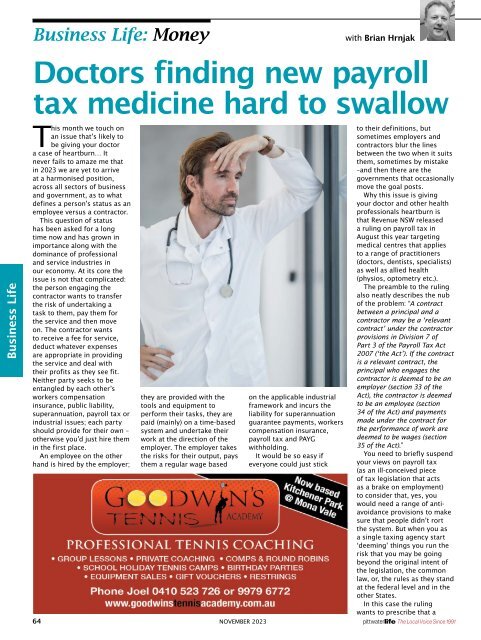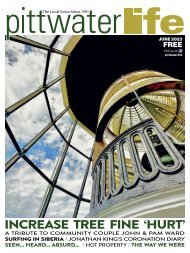Pittwater Life November 2023 Issue
THE MUSIC SPECIAL ISSUE 2023FREEpittwaterlife+ ROD WILLIS: HIS WILD ROCK JOURNEY WITH COLD CHISEL ANGRY MONA VALE ROAD DRIVERS VENT / LOCAL TREE PLAN THE WAY WE WERE / LEGO SHOW / SEEN... HEARD... ABSURD...
THE MUSIC SPECIAL ISSUE
2023FREEpittwaterlife+ ROD WILLIS: HIS WILD ROCK JOURNEY WITH COLD CHISEL
ANGRY MONA VALE ROAD DRIVERS VENT / LOCAL TREE PLAN
THE WAY WE WERE / LEGO SHOW / SEEN... HEARD... ABSURD...
Create successful ePaper yourself
Turn your PDF publications into a flip-book with our unique Google optimized e-Paper software.
Business <strong>Life</strong>: Money<br />
with Brian Hrnjak<br />
Business <strong>Life</strong><br />
Doctors finding new payroll<br />
tax medicine hard to swallow<br />
This month we touch on<br />
an issue that’s likely to<br />
be giving your doctor<br />
a case of heartburn… It<br />
never fails to amaze me that<br />
in <strong>2023</strong> we are yet to arrive<br />
at a harmonised position,<br />
across all sectors of business<br />
and government, as to what<br />
defines a person’s status as an<br />
employee versus a contractor.<br />
This question of status<br />
has been asked for a long<br />
time now and has grown in<br />
importance along with the<br />
dominance of professional<br />
and service industries in<br />
our economy. At its core the<br />
issue is not that complicated:<br />
the person engaging the<br />
contractor wants to transfer<br />
the risk of undertaking a<br />
task to them, pay them for<br />
the service and then move<br />
on. The contractor wants<br />
to receive a fee for service,<br />
deduct whatever expenses<br />
are appropriate in providing<br />
the service and deal with<br />
their profits as they see fit.<br />
Neither party seeks to be<br />
entangled by each other’s<br />
workers compensation<br />
insurance, public liability,<br />
superannuation, payroll tax or<br />
industrial issues; each party<br />
should provide for their own –<br />
otherwise you’d just hire them<br />
in the first place.<br />
An employee on the other<br />
hand is hired by the employer;<br />
they are provided with the<br />
tools and equipment to<br />
perform their tasks, they are<br />
paid (mainly) on a time-based<br />
system and undertake their<br />
work at the direction of the<br />
employer. The employer takes<br />
the risks for their output, pays<br />
them a regular wage based<br />
on the applicable industrial<br />
framework and incurs the<br />
liability for superannuation<br />
guarantee payments, workers<br />
compensation insurance,<br />
payroll tax and PAYG<br />
withholding.<br />
It would be so easy if<br />
everyone could just stick<br />
to their definitions, but<br />
sometimes employers and<br />
contractors blur the lines<br />
between the two when it suits<br />
them, sometimes by mistake<br />
–and then there are the<br />
governments that occasionally<br />
move the goal posts.<br />
Why this issue is giving<br />
your doctor and other health<br />
professionals heartburn is<br />
that Revenue NSW released<br />
a ruling on payroll tax in<br />
August this year targeting<br />
medical centres that applies<br />
to a range of practitioners<br />
(doctors, dentists, specialists)<br />
as well as allied health<br />
(physios, optometry etc.).<br />
The preamble to the ruling<br />
also neatly describes the nub<br />
of the problem: “A contract<br />
between a principal and a<br />
contractor may be a ‘relevant<br />
contract’ under the contractor<br />
provisions in Division 7 of<br />
Part 3 of the Payroll Tax Act<br />
2007 (‘the Act’). If the contract<br />
is a relevant contract, the<br />
principal who engages the<br />
contractor is deemed to be an<br />
employer (section 33 of the<br />
Act), the contractor is deemed<br />
to be an employee (section<br />
34 of the Act) and payments<br />
made under the contract for<br />
the performance of work are<br />
deemed to be wages (section<br />
35 of the Act).”<br />
You need to briefly suspend<br />
your views on payroll tax<br />
(as an ill-conceived piece<br />
of tax legislation that acts<br />
as a brake on employment)<br />
to consider that, yes, you<br />
would need a range of antiavoidance<br />
provisions to make<br />
sure that people didn’t rort<br />
the system. But when you as<br />
a single taxing agency start<br />
‘deeming’ things you run the<br />
risk that you may be going<br />
beyond the original intent of<br />
the legislation, the common<br />
law, or, the rules as they stand<br />
at the federal level and in the<br />
other States.<br />
In this case the ruling<br />
wants to prescribe that a<br />
64 NOVEMBER <strong>2023</strong><br />
The Local Voice Since 1991
















